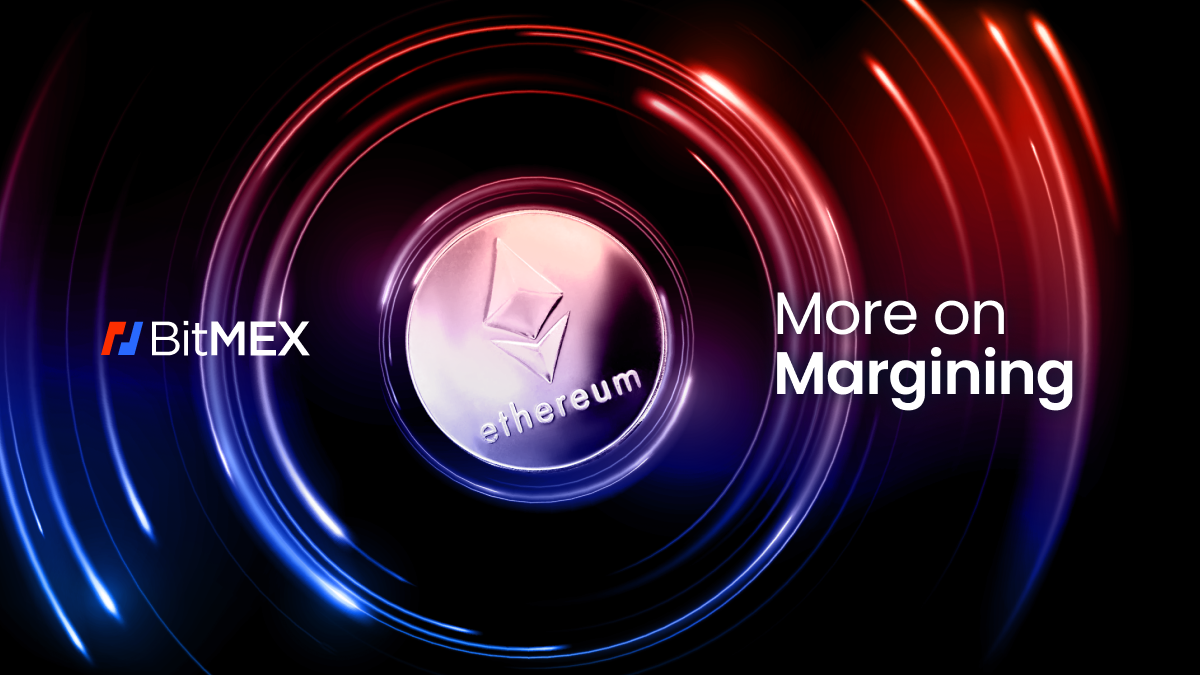
Since Q4 2021, BitMEX users have used Bitcoin and/or Tether (ERC-20) for margin and settlement. However, that all changes tomorrow, when we launch ETH-margined contracts.
Ahead of ETH margin and settlement capabilities arriving on our platform, this blog takes a closer look at margins in crypto trading – and the finer details of our Ether-margined contracts.
Read on to learn more, or deposit ETH into your BitMEX Wallet today.
What Does Margin Mean in Crypto?
Margin trading allows users to open positions far greater than their “real” balance by borrowing funds from a third party (e.g. an exchange, like BitMEX). It’s also sometimes referred to as ‘trading with leverage’, because it provides traders with increased purchasing power to leverage their positions. Traders with leveraged positions face more risk, but also the possibility of greater gains. This is different to regular spot trading.
In the crypto derivatives space, margin refers to the amount of funds needed to enter into a leveraged position. So when we refer to our future or perpetual listings as ETH-margined contracts, we mean that the contract is margined and settled in Ether. On launch date, the available ETH-margined contracts will be inverse contracts – ETH is the base and margin currency and USD is the quote and notional currency. Note that this means you can trade ETH vs USD without having to touch USD at all.
When trading futures and perpetual swap contracts on BitMEX, traders are not required to post 100% of their collateral as margin – meaning users can trade with up to 100x leverage on some of our contracts. In other words, users can trade notional amounts that are multiples of their collateral.
What is the Difference Between Initial vs Maintenance Margin?
Each listing on BitMEX comes with specs on each contract’s initial and maintenance margin. Here’s what they mean:
- Initial margin: The minimum initial amount needed to enter a position.
- Maintenance margin: The minimum amount needed to keep that position. If you cannot fulfill your maintenance margin, you will be liquidated and your maintenance margin will be lost.
How is Cross Margin and Isolated Margin Different?
At BitMEX, we employ two different margining methods:
- Cross margin: Margin is shared between open positions with the same settlement currency (e.g. ETH). When needed, a position will draw more margin from the total account balance of the corresponding cryptocurrency to avoid liquidation*. Note: This is the default margin setting on BitMEX.
- Isolated margin: Margin assigned to a position is restricted to a certain amount. If the margin falls below the maintenance margin, the position is liquidated. However, you can add and remove margin at will under this method. When trading in isolated margin mode on BitMEX, you are able to adjust your leverage on the fly via the leverage slider.
About Our ETH-Margined Contracts
BitMEX currently offers perpetual and futures contracts that are margined and settled in XBT or USDT (ERC-20). This all changes tomorrow, when users will be able to trade a suite of contracts that are margined and settled in ETH.
Here’s the lowdown on our ETH-margined contracts:
- On 31 May at 04:00 UTC, we will list a perpetual swap (ETHUSD_ETH) and June (ETHUSDM22_ETH) and September (ETHUSDU22_ETH) Futures. These contracts on ETHUSD all have inverse payoffs, notional in USD and margin in ETH. As usual, these contracts are made visible 24 hours before trading starts so you can see the contract details now. When trading starts you can find ETHUSD_ETH here and all the contracts will be available on our
Hot list on the trading page.
- To start trading Ether-margined contracts, users will first need to deposit ETH on BitMEX. Users can also choose to send ETH they already have on Ethereum, to buy ETH with fiat, purchase ETH via BitMEX Spot, or convert other cryptocurrencies into ETH.
- ETH can only be used as margin for contracts that are margined in ETH. This is denoted in the contract name with the suffix “_ETH”.
- API users can find the margin currency as Settlcurrency in the Instrument table as Gwei – try it at this link. We count in gwei so we can accommodate smaller trades (1 ETH is 1 billion Gwei, or 1 Gwei = 0.000000001 ETH).
- Traders can use cross margin, to use their total account balance of a corresponding currency as a shared margin across contracts margined in that currency.
- Our insurance fund will include an ETH balance to support liquidations from our ETH-margined listings. The insurance fund is allocated across margin currencies, and will be rebalanced between currencies from time to time.
Coming Soon: More Listings
It’s going to be a big month. Our XBTN22 monthly futures contract will go live on 1 June 2022 at 04:00 UTC. Shortly after, our Q3 2022 futures listings will become available and tradable from June 15 2022 at 04:00 UTC. More to come.
A Quick Reminder About the BitMEX Spot Sweepstakes
Until 17 July 2022 at 11:59 PM HKT, BitMEX users who trade $250 USD+ worth of any cryptocurrency on BitMEX Spot will be automatically entered into our biggest giveaway ever, and stand the chance to win a share of $1,000,000 USD in crypto and prizes. You can click here for further details.
To be the first to know about our product launches, spot trading pairs, and giveaways, connect with us on Discord, Telegram, and Twitter.
If you have any questions in the meantime, please contact Support.
Related
The post appeared first on Blog BitMex






